Rudolf Arnheim

Rudolf Arnheim
Rudolf Arnheimwas a German-born author, art and film theorist, and perceptual psychologist. He learned Gestalt psychology from studying under Max Wertheimer and Wolfgang Köhler at the University of Berlin and applied it to art. His magnum opus was his book Art and Visual Perception: A Psychology of the Creative Eye. Other major books by Arnheim have included Visual Thinking, and The Power of the Center: A Study of Composition in the Visual Arts. Art and Visual Perception was revised, enlarged...
NationalityGerman
ProfessionArtist
Date of Birth15 July 1904
CountryGermany
Man's striving for order, of which art is but one manifestation, derives from a similar universal tendency throughout the organic world; it is also paralleled by, and perhaps derived from, the striving towards the state of simplest structure in physical systems.
It would be most wholesome if for at least twenty years art historians were forbidden to refer to any derivations. If they were not allowed to account for a work of art mainly by tracing where it comes from, they would have to deal with it in and by itself--which is what they are most needed for.
Some popular quotations smell of airless closets. They exhale the stale imagination of the intellectual lower middle class. "Suspension of disbelief" has become one of them. Dressed up as a scintillating double negation, it serves the pedestrian notion of art as illusion.
Just as a chemist "isolates" a substance from contaminations that distort his view of its nature and effects, so the work of art purifies significant appearance. It presents abstract themes in their generality, but not reduced to diagrams.
The foreign accent was a promise, and indeed, all over the country, European imports added spice to the sciences, the arts, and other areas. What one had to give was not considered inferior to what one received.
Art is continually working to take the crust of familiarity off everyday objects.
Both art and science are bent on the understanding of the forces that shape existence, and both call for a dedication to what is. Neither of them can tolerate capricious subjectivity because both are subject to their criteria of truth. Both require precision, order, and discipline because no comprehensible statement can be made without these. Both accept the sensory world as what the Middle Ages called signatura regrum, the signature of things, but in quite different ways.
The dance, just as the performance of the actor, is kinesthetic art, art of the muscle sense. The awareness of tension and relaxation within his own body, the sense of balance that distinguishes the proud stability of the vertical from the risky adventures of thrusting and falling--these are the tools of the dancer.
The principle of parsimony is valid esthetically in that the artist must not go beyond what is needed for his purpose.
No mature style of art in any culture has ever been simple. In certain cultures, an overall symmetry may conceal the complexity of the work at first glance.
Form is sometimes considered a mere spice added by the artist to the representation of objects in order to make it pleasurable.
The arts, as a reflection of human existence at its highest, have always and spontaneously lived up to this demand of plenitude. No mature style of art in any culture has ever been simple.
Now the work of art also represents a state of final equilibrium, of accomplished order and maximum relative entropy, and there are those who resent it. But art is not meant to stop the stream of life. Within a narrow span of duration and space the work of art concentrates a view of the human condition; and sometimes it marks the steps of progression, just as a man climbing the dark stairs of a medieval tower assures himself by the changing sights glimpsed through its narrow windows that he is getting somewhere after all.
Good art theory must smell of the studio, although its language should differ from the household talk of painters and sculptors.